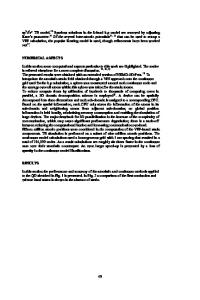Luminescence of a Two-Particle Complex from a Spherical Quantum Dot and Plasmon Nanoglobule in an External Magnetic Fiel
- PDF / 936,570 Bytes
- 8 Pages / 612 x 792 pts (letter) Page_size
- 106 Downloads / 273 Views
MONICS
Luminescence of a Two-Particle Complex from a Spherical Quantum Dot and Plasmon Nanoglobule in an External Magnetic Field M. G. Kucherenkoa, * and V. M. Nalbandyana a Center
of Laser and Information Biophysics, Orenburg State University, Orenburg, 460018 Russia *e-mail: [email protected] Received May 18, 2020; revised May 18, 2020; accepted July 7, 2020
Abstract—Based on a specially created theoretical model, frequency dependences of the luminescence intensity of the two-component “exciton-activated semiconductor quantum dot (QD)–plasmon nanoparticle (NP)” system in a constant magnetic field are calculated. In contrast to previous models, it goes beyond the scope of the approximation of dipole polarizability of a spherical NP. The induced NP dipole moment was calculated taking into account the inhomogeneous character of the field created by the QD containing an exciton. It is shown that, with a change in induction of the external magnetic field, one can observe transformation of exciton luminescence spectra of such system as a result of the exciton–plasmon interaction between cluster particles and magnetization of the NP electron plasma. The competition of radiative and nonradiative decay channels of the excited state of a two-particle complex is taken into account. It is shown that, in rate spectra of the nonradiative energy transfer from the QD to the NP, as well as of spontaneous emission of the nanocomplex, stripes of higher order multipole transitions are formed in addition to dipole stripes; they are split into doublet components in the magnetic field. Keywords: spherical quantum dot, magnetized plasmon nanoparticle, luminescence of the two-particle complex, multipole polarizabilities DOI: 10.1134/S0030400X20110156
INTRODUCTION Typical objects of present-day nanoelectronics and photonics are different-shaped semiconductor and metal nanoparticles (NPs) in which collective electronic excitations in the form of excitons and plasmons are generated under the action of electromagnetic radiation [1, 2]. The interaction of excitons and plasmons between each other attracts significant interest owing to its decisive role in surface-enhanced Raman spectroscopy (SERS) [3], exciton luminescence of hybrid NPs near metal surfaces and their influence on heterogeneous catalysis reactions [4], in the increase in the efficiency of solar cells [5], as well as in many other processes in different fields of nanoelectronics. In connection with this, for more effective and precise control for technological processes and operation of new-generation electronic devices, it becomes important to develop methods of operational control for the intensity of the exciton–plasmon interaction in nanostructures using an external magnetic field. Excitons generated at quantum dots (QDs) or molecular J-aggregates can form strong or weak coupling with plasmons depending on the structure of the nanosystem and its energy characteristics [6–8], which leads to different unique optical properties.
Metal NPs and planar structures with a plasmon l
Data Loading...










